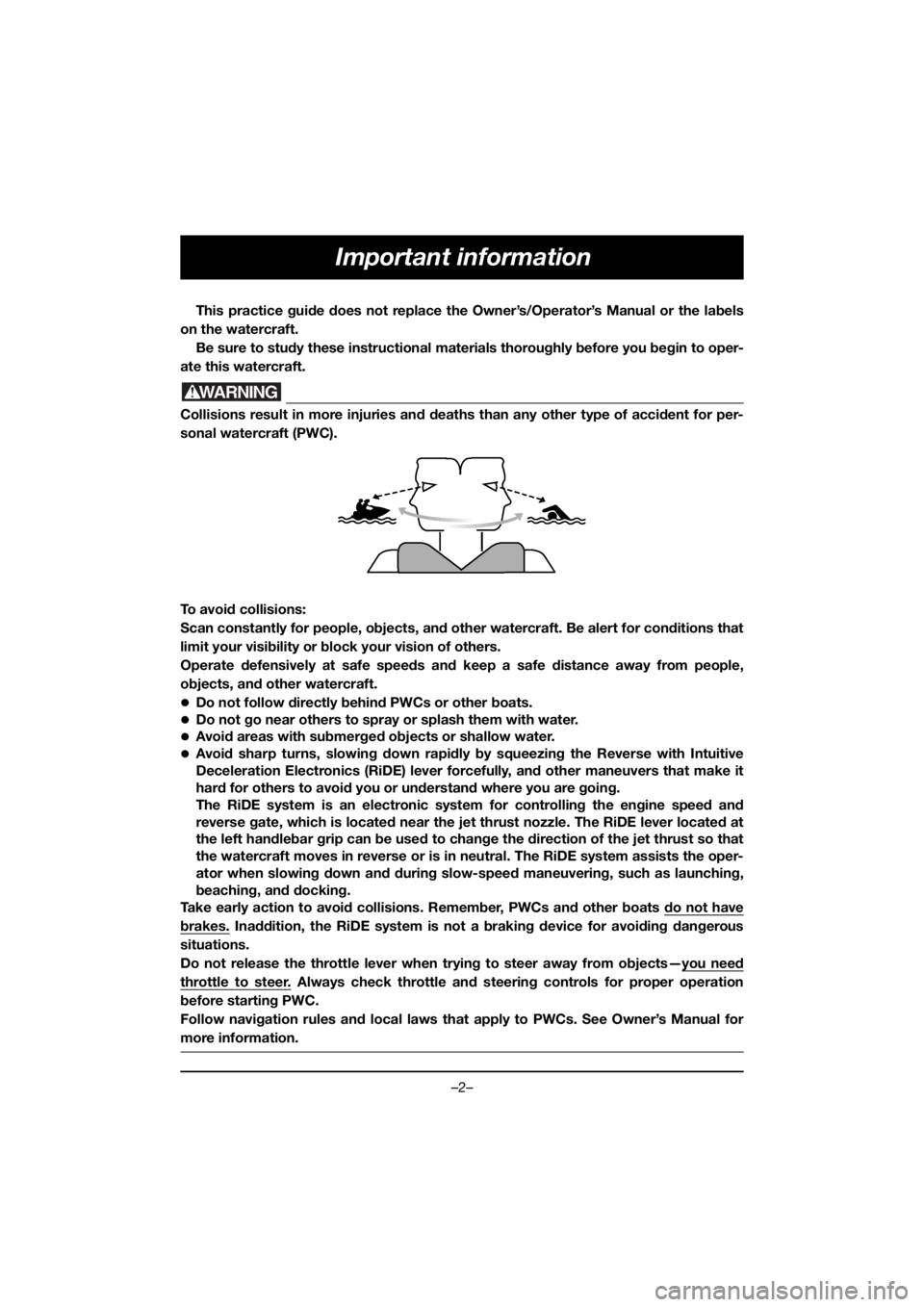check engine YAMAHA EXR 2019 ΟΔΗΓΌΣ ΧΡΉΣΗΣ (in Greek)
[x] Cancel search | Manufacturer: YAMAHA, Model Year: 2019, Model line: EXR, Model: YAMAHA EXR 2019Pages: 198, PDF Size: 3.74 MB
Page 7 of 198

–2–
Important information
This practice guide does not replace the Owner’s/Operator’s Manual or the labels
on the watercraft.
Be sure to study these instructional materials thoroughly before you begin to oper-
ate this watercraft.
WARNING
Collisions result in more injuries and deaths than any other type of accident for per-
sonal watercraft (PWC).
To avoid collisions:
Scan constantly for people, objects, and other watercraft. Be alert for conditions that
limit your visibility or block your vision of others.
Operate defensively at safe speeds and keep a safe distance away from people,
objects, and other watercraft.
Do not follow directly behind PWCs or other boats.
Do not go near others to spray or splash them with water.
Avoid areas with submerged objects or shallow water.
Avoid sharp turns, slowing down rapidly by squeezing the Reverse with Intuitive
Deceleration Electronics (RiDE) lever forcefully, and other maneuvers that make it
hard for others to avoid you or understand where you are going.
The RiDE system is an electronic system for controlling the engine speed and
reverse gate, which is located near the jet thrust nozzle. The RiDE lever located at
the left handlebar grip can be used to change the direction of the jet thrust so that
the watercraft moves in reverse or is in neutral. The RiDE system assists the oper-
ator when slowing down and during slow-speed maneuvering, such as launching,
beaching, and docking.
Take early action to avoid collisions. Remember, PWCs and other boats do not have
brakes. Inaddition, the RiDE system is not a braking device for avoiding dangerous
situations.
Do not release the throttle lever when trying to steer away from objects—you need
throttle to steer. Always check throttle and steering controls for proper operation
before starting PWC.
Follow navigation rules and local laws that apply to PWCs. See Owner’s Manual for
more information.
F4L-T70-forPrint.book Page 2 Friday, July 13, 2018 11:00 AM
Page 10 of 198

–5–
Exercise 1: Controls
Objective:
This exercise trains you to locate and operate the watercraft’s controls without looking or
hesitating. You must master this skill so you can scan constantly for people, objects, and
other watercraft as you maneuver, rather than taking away concentration to find a control.
Skills:
Knowing where every control is and how to use it without having to stop and think about
it.
Directions:
Drill 1: Identifying the components and controls
Read your Owner’s/Operator’s Manual to identify the watercraft’s main components and
controls.
Do not just assume you know how a control works, read the instructions to be sure!
Drill 2: Pre-operation checks
Practice performing the pre-operation checks listed in your Owner’s/Operator’s Manual.
You learned where everything is in Drill 1.
Now make sure everything is working properly. Pay particular attention to the steering
controls and the throttle lever.
Drill 3: Operating positions
With the watercraft on land and the engine off, board and become familiar with the cor-
rect operating positions described in your Owner’s/Operator’s Manual. Then, with your
eyes facing straight ahead, locate each control and verify that you know how to use it.
Continue this drill until you feel comfortable with the controls.
F4L-T70-forPrint.book Page 5 Friday, July 13, 2018 11:00 AM
Page 17 of 198

–12–
Exercise 4: Trolling speed maneuvering
Objective:
This exercise familiarizes you with the watercraft’s handling characteristics at trolling
speed. It teaches techniques you will use when beaching, docking, or approaching
objects.
Skills:
Starting and turning at trolling speed.
Directions:
Drill 1: Moving straight and turning at trolling speed
1. Board the watercraft, and check for people, objects and other watercraft.
2. Start the engine and go straight ahead.
3. Begin to turn, making a large figure eight about 15–21 m (50–70 ft) long. Do not apply
throttle.
Drill 2: Making full-lock turns at trolling speed
1. Turn the handlebars as far as possible in either direction. Allow the watercraft to turn
360°.
2. Practice turning both clockwise and counterclockwise to get a feel for how the water-
craft responds to handlebar movement.
F4L-T70-forPrint.book Page 12 Friday, July 13, 2018 11:00 AM